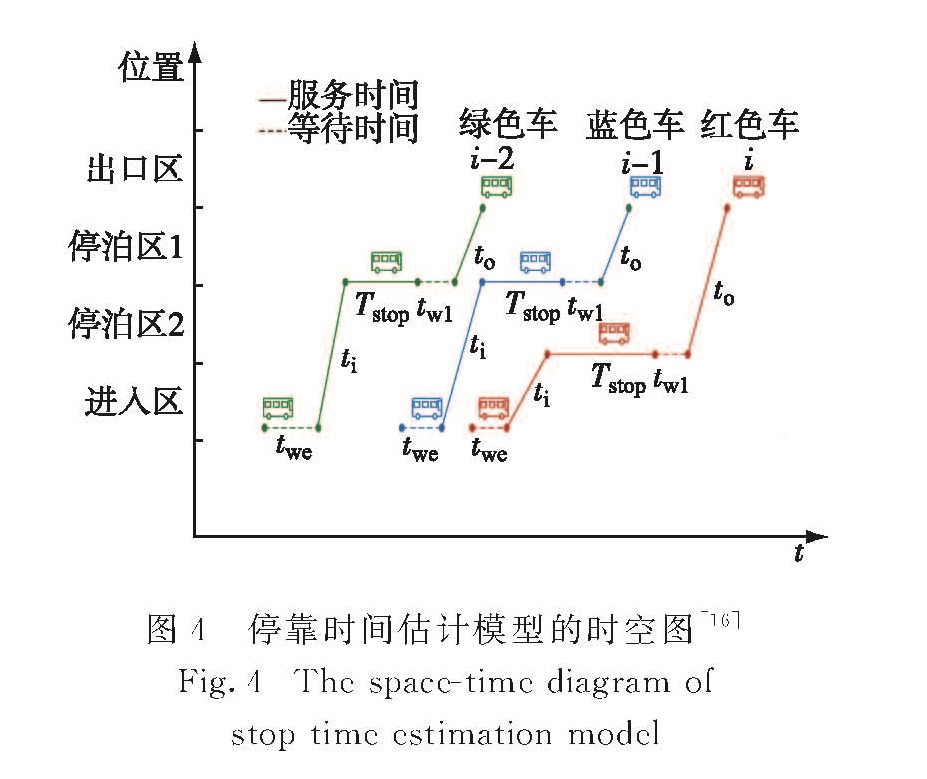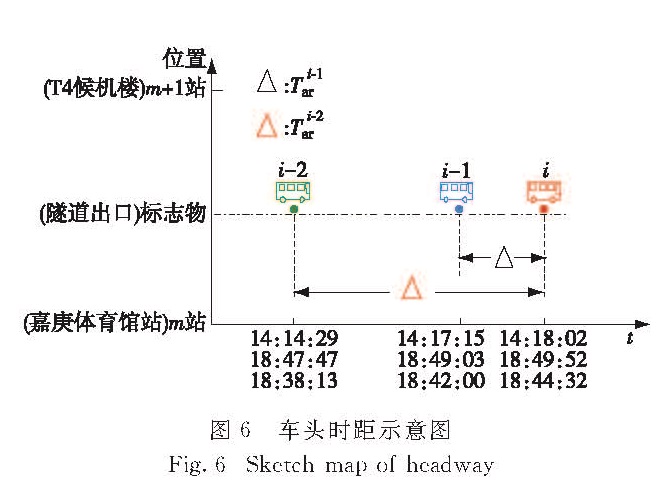(1.厦门大学信息科学与技术学院,福建 厦门 361005; 2.福建信息职业技术学院,福建 福州 350003)
(1.School of Information Science and Engineering,Xiamen University,Xiamen 361005,China; 2.Fujian Polytechnic of Information Technology,Fuzhou 350003,China)
support vector regression; bus rapid transit; arrival time; stop time; headway
DOI: 10.6043/j.issn.0438-0479.201606039
备注
选择ε-支持向量机回归(ε-SVR)算法预测快速公交(BRT)车辆的到站时间,以提高公共交通的准点性.分别对BRT的停靠时间和路段行驶时间建立模型.根据分析,在停靠站时间预测建模过程中选取车头时距、时段、天气等7维特征向量作为模型输入,采用人工调查法,对厦门BRT-1路的数据进行采集,归一化处理后建模.仿真结果显示该模型能够比较准确地预测厦门BRT-1路的运行路线到站时间,并验证天气因素对该线路的到站时间预测影响最大.
In this article,we select ε-support vector machine regression(ε-SVR)algorithm to predict the bus rapid transit(BRT)arrival time,in order to improve the public transport on time.The bus stop time and road travel time models are established.During the modeling process,seven dimensional features such as the headway,time,weather etc.,are chosen as model inputs.Artificial investigation method is used to collect the data of Xiamen BRT-1.These data are normalized during the modeling process.Simulation results show that the model can accurately predict bus running time of Xiamen BRT-1.Results verify that weather factors exert the highest influence on the arrival time of Xiamen BRT-1.
引言
城市公共交通具有集约高效、节能环保等优点,优先发展公共交通是缓解交通拥堵、提高人民群众生活品质的必然要求.我国政府早在2004年就提出“优先发展城市公共交通”的政策方针[1].据资料显示,自“十一五”规划以来,借助智能公交[2]技术,我国公共交通的分担率在缓步提升,但相对西方国家60%的分担率还有一定的差距.目前多数城市公共交通车速慢、候车时间长、准点率差等问题直接影响了公交车对公众出行的吸引力.改善城市公交的服务性能,提高乘客满意度[3],有助于吸引更多的乘客采用绿色、环保、节能的公交出行方式.
国内外诸多学者对公交车的行程时间及到站时间进行了研究.牛虎[4]将非参数回归方法应用到公交车到站时间的预测中,并比较了历史平均模型、人工神经网络模型和非参数模型的预测效果,实验结果发现非参数模型的预测精度最高.陈圣兵等[5]提出一种非计算的条件映射预测公交车到站时间模型,但在实际的预测系统中,因类别数大使得算法的效率明显下降,很难达到实际要求.Deeshma等[6]针对班加罗尔的公交车出行时间,采用Kalman 滤波模型较好地预测了出行时间.王茁[7]分析3种公交到站时间预测模型(Kalman 滤波模型、BP(back propagation)神经网络模型、时间序列模型),发现Kalman 滤波预测模型仅适用于平峰时段,BP神经网络模型适用于高峰和低峰时段.Bai等[8]提出了基于支持向量机(support vector machine,SVM)和Kalman滤波的混合模型,可以预测公交车在下一站的到站时间.Zhong等[9]提出了改进的SVM模型,利用格鲁布斯检验法在该模型中对输入数据进行滤波,提高了预测准确性.组合预测模型将不同的预测方法进行组合,可以有效利用各种模型的优点.根据公交到站时间预测研究现状来看,支持向量机回归(support vector regression,SVR)研究的是在小样本下的统计学规律,它具有很强的学习能力,其泛化能力明显优于神经网络,很容易在拟合程度与泛化水平上进行平衡.因此,本研究选取了SVR来进行快速公交(BRT)运行时间的预测.
1 BRT公共交通的特性及影响因素分析
BRT是一种介于常规公交与轨道交通之间的公共交通出行方式,具有运量大、快捷、舒适、低能耗、低污染的特点.厦门高架BRT系统除了具有传统BRT的公交专用道、新型大容量公交车辆、水平登乘、车外售检票等特征外,还采用双向2车道、独立路权的高架BRT专用路,没有横向和纵向干扰,不存在分流延误,车流比较稳定.
厦门BRT是厦门市交通的主动脉.但作为第一个成网络运营的高架BRT系统,在准点性和方便性方面还有较大的提升空间.本研究以厦门BRT系统为背景,采用SVR算法对BRT系统的到站时间进行预测,以提升厦门BRT系统的服务水平.
表1 厦门BRT运行影响因素[10]
Tab.1 The related factors in BRT operation in Xiamen[10]公交车路段行驶时间 站点停靠时间道路 交通 车辆 人 天气 突发事件 站点 乘客公交车沿线道路的等级、车道数、断面型式及通行能力等 受到社会车辆、非机动车和其他公交车辆的影响,不同交通流的流量、密度、速度相互影响 车辆的体积、最高车速、加/
减速性能 司机的年龄、性别、驾龄等影响其驾驶技
术、驾驶习惯及反应速度 高温、低温天气会影响车辆本身的性能,降雨、降雪天气会造成路面湿滑,影响驾驶员视线 交通事故、临时交通管制等 站台的型式、长度、公交车线路数、站台泊位等 上/下车乘客
的数量以及乘客上/下车速度
由表1可以看出,BRT道路交通系统是一个时变的、复杂的非线性多维动态系统,除了具备一些动力学特性之外还具备周期性、随机性和时空相关性等特点,天气情况、司机状态、突发事件等因素都会对交通系统运行产生影响,这些不确定性因素给路段行程时间及停靠服务时间预测带来了很大的困难.但随着研究的深入,人们发现道路交通系统并不是一个完全不确定的随机系统,而是一个以内在约束性为基础,同时具备动力学特性、周期性和时空相关性的系统.这些特点使其表现出很强的可预测性,研究人员可以通过构建合理的数学模型来取得良好的预测效果.
2 ε-SVR算法
SVR是支持向量在函数回归领域的应用,它不仅继承了SVM解决小样本、非线性、高维数、局部极小点等问题[11],还能够解决非线性回归问题.目前主要有ε-SVR和v-SVR两种方式.本研究采用ε-SVR来进行预测,其基本原理[12]是:给定m个数据样本{yi,xi}mi=1,其中,xi和yi分别为输入和输出样本.输入样本x首先通过非线性映射将原空间中的输入样本映射到M维特征空间中,完成线性回归,然后在这个特征空间中建立一个线性模型来估计回归函数,公式如下:
f(x,w)=w·(x)+b,(1)
其中,w为权向量,b为阈值.对于给定的训练数据集(y1,x1),(y2,x2),…,(yn,xn),采用ε不敏感损失函数,对应的SVM称为ε-SVM.输入样本经过变换,可以通过在高维空间中求解线性回归问题以达到解决原空间中的非线性回归问题,定义不敏感损失函数如下:
Lε(xi,yi,f)=max{0,|yi-f(xi)|-ε}.(2)
SVR问题就是要找到合适的函数f(x)以拟合这些训练点,使得观测值yi与函数预测值f(x)之间的误差最小,其误差可以用ε-不敏感损失函数表示.如图1所示,当训练点位于图中的两条虚线内(即ε-带,带内的训练点用空心圆点表示)时,则认为训练点的误差为0.
SVR模型的经验风险最小和结构风险最小化目标函数是:
minw1/2‖w‖2+c∑ni=1(Lε(xi,yi,f).(3)
转换成二次规划问题并在求解过程中,引入非负松弛变量ξi和ξ*i,得到式(4):
minw1/2‖w‖2+c∑ni=1(ξi+ξ*i),
满足
{yi-w·(x)+b≤ε+ξ*i,
w·(x)+b-yi≤ε+ξi,
ξi,ξi*≥0.(4)
式(4)引入拉格朗日函数进行优化,通过解对偶问题得到式(1)的解:
f(x)=∑lsvi=1(αi+α*i)K(xi,x)+b.(5)
其中:αi,α*i(i=1,2,…,n)为拉格朗日乘子,αi,αi*只有一小部分不为0,它们对应的样本就是支持向量; lsv为支持向量的个数; K(xi,x)为核函数.常用的核函数有多项式核函数、高斯径向基核函数、Sigmoid核函数以及傅里叶级数核函数等.
从SVR模型结构可以看出,它不要求具体的函数形式,一个训练好的SVR模型即可捕获非线性的输出变量(如公交车路段间运行时间)和输入变量(如天气、时间等因素)之间的复杂关系.因此,将SVR用于一些很难用数学公式表述的复杂系统(如公交系统)进行预测是非常有效的.另外,SVR算法是一个凸二次优化问题[13],能够保证找到的极值就是全局最优解,而不像其他一些非线性优化方法易陷于局部最小点.
3 基于ε-SVR的BRT到站时间预测模型
本研究对BRT车辆到站时间预测模型包括两部分:路段运行时间预测和车站停靠时间预测.首先对通过厦门BRT-1路采集到的数据进行处理,接着分别建立ε-SVR模型来预测车站停靠时间和路段运行时间,最后建立模型并进行实验验证与效果分析.
3.1 预测模型的影响因素分析预测模型采用SVR算法,对BRT车辆在任意两个相邻公交站点之间路段上的运行时间和在某一站点的停车服务时间进行预测.
根据公交到站时间模型的需求分析,先选择时间段Ct、天气Cw、是否为节假日Ch 3个维度[14],作为影响BRT到站时间预测的部分输入,如表2所示.
3.2 BRT车辆停靠时间分析对BRT的研究发现23%的时间花费在乘客上下车(即停靠时间),而52%的时间在路段上行驶[15],可以看出,站点停靠对BRT总运行时间的影响很大.
BRT停靠站的场景如图3所示[16],具备两个停靠位的停靠站,与厦门BRT的停靠位类型一致.图中红色车表示即将进站车辆,蓝色车表示预测车的前一辆公交车.在图3场景中A、B 2种场景下红色车辆进站都无需等待,直接进空闲的停靠位,而场景C中红车辆需要排队等待前车驶离方可进站.本文中只考虑A,B 2种场景下的车辆进站情况,即预测中不考虑排队等候时间.
BRT车辆在站点的停靠过程可以描述为:车辆减速进入停靠站—开启车门—在站点停车上下乘客—关闭车门—车辆加速驶离停靠站.BRT车辆进出停靠站总时间即停靠站服务时间包括车辆进站减速时间、车辆到站停靠时间和车辆出站加速时间,如图4所示.图中所示的第i辆红色车即为所预测的车辆,蓝色和绿色均表示其前2辆车.每辆车的停靠站过程均由各自的曲线表示:虚线twe、twl分别表示进站、出站排队等待时间,本文中不予考虑; 实线ti、Tstop、to分别表示进站减速时间、停靠时间和出站加速时间.故BRT车辆进出停靠站总时间Tdwell计算公式为:
Tdwell=ti+Tstop+to.(6)
根据TCRP Report100,车辆开/关门时间一般为1~3 s.根据HCM 2000,车辆的停靠时间分布属于连续型分布,可得到车辆停靠时间T的计算公式[17]
T=(n1·t1+n2·t2)/2+t0,(7)
式中:n1、n2分别为车辆上/下车人数(人/辆); t1 、t2分别为单位乘客上下车时间(s/人); t0为车辆开/关门时间.
一般来说,某条线路的第i辆车的停靠时间Tistop 可以通过下式计算得到:
nb=min( ∫tiar-ti-1arQpeddt,Cbus(1-p)+na),(8)
Tistop=t0+(na×ta^-+nb×tb^-)/2.(9)
式中:na,nb分别表示第i辆车的下车乘客数和上车乘客数; tiar,ti-1ar 分别表示第i辆和第i-1辆车的到站时间,单位s; Qped 表示该线路候车乘客的到达分布函数; Cbus表示车辆的最大载客量; P表示车辆到达本站前的满载率; ta^-,tb^-分别表示乘客的平均下车时间和平均上车时间.
对于上述公式,本文中假设公交车的载客能力能够满足站台候车乘客的需求,即∫tiar-ti-1arQped dt≤Cbus(1-p)+na.另一方面,由于受车门数量的限制,站台乘客的总上车时间一般要大于在车乘客的总下车时间,即na×ta^-≤nb×tb^-,同时(na×ta^-+nb×tb^-)/2≤nb×tb^-,此时公交车的停站时间为:
Tistop=t0+t0^-×∫tiar-ti-1arQpeddt.(10)
同理,对于第i辆车之前的第j辆车(j<i)也有:
Tjstop=t0+tb^-×∫tjar-tj-1arQpeddt=t0+tb^-×
(∫tiar-tj-1arQped dt-∫tiar-tjarQped dt).(11)
令t0和乘客的平均上车时间tb^-都取定值.候车乘客的到达分布与车辆的停靠时间以及车头时距存在对应关系:
Qped=f(T jstop,(tiar-tj-1ar),(tiar-tjar)).(12)
结合式(10)~(12),第i辆车的停靠时间Tistop 可以表示为:
Tistop=F(Qped,(tiar-ti-1ar))=F(Tjstop,(tiar-
tj-1ar),(tiar-tjar),(tiar-ti-1ar)),
(j=i-1,i-2,…).(13)
可见,第i辆车在本站的停靠时间Tistop 与之前的第j辆车的停靠时间Tjstop 有关,同时也与前2辆车的车头时距有关.综上所述,本文中选取当前车与前2辆车的车头时距 Tjar=tiar-tjar,前2辆公交车的停靠时间Tjstop(j=i-1),以及时段、天气和节假日作为预测模型的输入特征向量(包括7个维度),即:Tistop=F'([Ti-1stop,Ti-2stop,Ti-1ar,Ti-2ar,Ct,Cw,Ch]).
本文中采用ε-SVR模型,基于历史数据对上述输入特征向量xistop=(Ti-1stop,Ti-2stop,Ti-1ar,Ti-2ar,Ct,Cw,Ch)与Tistop 的关系进行拟合,从而得出BRT车辆在车站停靠时间的预测模型.
另外,根据BRT车辆平均ti为2.9 s[18],平均to为4.4 s,即可计算Tdwell.
3.3 BRT在相邻两站的运行时间BRT在相邻两站的运行时间如图5所示.
Tm,m+1=T'm,m+1+Tdwell,(14)其中:Tm,m+1为车辆在第m站和m+1站间的运行时间; T'm,m+1 为车辆通过第m站和m+1站间路段的自由行驶时间.不考虑车辆之间的差别,第i辆车辆在某路段的自由行驶时间主要受车辆在路段内的平均车速(-overv)m,m+1,以及时段、天气、是否节假日的影响.故本文中选取的路段自由行驶时间预测模型的输入特征向量为(包括4个维度):x'm,m+1=((-overv)m,m+1,Ct,Cw,Ch).由此,Tm,m+1 即可预测.
4 实验设计与仿真验证
4.1 数据采集厦门BRT-1路岛内段和联络线采用高架方案,岛内段高架桥长15.280 km,整条线路为全封闭线路,采用放射线+区间线+联络线的模式[19]; 设有25个站点,公交车站采用站外售票、水平登乘.针对3车门同时上下客的车型,21个主要站点进行随车数据采集,采集的数据包括连续3辆车辆到达这21个站点的时刻、第3辆车与前2辆车的车头时距、调查的时间段和天气情况以及工作日/节假日信息,共得到了360组有效样本.其中取280组数据用来训练建模,其余80组数据进行测试样本.在预测前还需对数据进行归一化处理.
在对车头时距的采集中首先选取两站之间的标志物,如:在嘉庚体育馆站与T4候机楼站之间选取隧道出口为标志物,在产业研究院站与大学城站之间选取信号塔为标志物,在二市站与斗西路口站则选取公园小学(右)为标志物等.在每两站之间选取合适的标志物后,采集连续运行的3辆BRT到达标志物的时间,差值即为模型所需的车头时距数据,如图6所示.
4.2 ε-SVR模型核函数及参数的选择在进行预测前,还需要对ε-SVR模型所使用核函数的类型及其参数进行选择.当处理线性不可分样本时,将低维空间的输入映射到高维空间,计算出经过核函数变化后在高维空间里向量的内积值,最终转换为线性可分问题,这是核函数的作用[20].ε-SVR模型常用的核函数有多项式核函数、高斯径向基核函数、Sigmoid核函数以及傅里叶级数核函数等.对于ε-SVR,径向基核函数K(xi,x)可以用低维空间中的内积来表示高维空间中的内积,从而弥补了传统预测方法的缺点,使得计算量不会呈指数增加.故本文中采用径向基核函数:K(xi,x)=exp(-γ‖x-xi‖2),其中γ为核参数.
参数C在确定的特征空间中,表征学习机器对不敏感系数ε区域以外的数据样本的惩罚程度,故称惩罚因子.在任何一个数据子空间中,都会存在一个惩罚因子C的取值使得SVR推广能力最好且结构风险最小.核宽度γ能够决定输入数据样本的范围特性和支持向量之间相关程度的大小,SVR模型性能的优劣很大程度上由γ取值的大小决定.ε能够决定拟合函数对数据样本的不敏感区域的大小、支持向量的数目以及模型推广能力的大小[21].对于参数C、ε、γ的选择,采用了最常用且可靠的网格搜索来确定.如图7所示,确定了C为256,r为0.011 8,同时选取不敏感系数ε为0.1.然后,需要对SVR进行训练,寻找用来预测的支持向量,该SVR应随数据库更新而重新训练.训练好的SVR可以用来预测车辆到达各站点的时间.
4.3 仿真效果分析利用MATLAB R2010b软件及台湾大学林智仁教授开发的LIBSVM-3.1 SVM C++类库进行仿真,实现了对ε-SVR的求解过程并进行验证.其中LIBSVM工具包为用户立提供了丰富的开发工具和编程接口,可以实现数据归一、训练集读取、训练、预测等机器学习功能.
图8 工作日的不同时段ε-SVR(7)与ε-SVR(5)模型的对比
Fig.8 The comparison of ε-SVR(7)and ε-SVR(5)models at different periods of working day考虑BRT的运行相对比较稳定,在建立到站时间预测模型时,本研究针对不同的影响因素建立2种模型,先设计了只包含前2辆车到站时间、时间段、天气和节假日5个输入变量的ε-SVR,称为ε-SVR(5),相应的本文中提出的模型则记作ε-SVR(7),并计算了2种模型在各路段的预测结果的均方误差,如图8所示.可以看出,在4种模式下,除了第1路段,ε-SVR(7)模型在其他所有路段的预测误差都低于ε-SVR(5)模型,说明了本文中提出的预测模型具有更好的预测性能.ε-SVR(5)不具更多的动态特性,因此预测的误差就会相对较高,而且波动的幅度也较大; 但是ε-SVR(7)模型的误差则只是在一个很小的范围内扰动,没有出现非常明显的波动,这符合我们的期望.
从图8中还可以看到,在高峰时段和平峰时段预测模型的误差没有很明显差别,这是因为RT专属路权的运行方式,不受沿途其他车辆交通拥堵等状况的干扰.结果显示,晴天误差在1 min左右,而雨天的误差相对较大在2~3 min,表明天气因素对BRT的影响很大.在雨天ε-SVR预测效果明显比晴天时期差,这是因为雨天路滑,影响驾驶员的可视范围,车头时距会增大等复杂状况,使得雨天误差比较大.
5 结 论
本研究基于ε-SVR算法对厦门BRT-1路运行路线到站时间进行预测,ε-SVR(7)模型准确率较高,将对提升厦门BRT系统的服务水平将有一定的帮助.但这一预测方法对于普通公交车路线到站时间的预测精度还有待验证.如果能够获得实时的公交车辆运行数据,该模型有望用于进行车辆的在线预测.
- [1] 向红艳,彭学文.公交到站时间预测研究现状与发展趋势[J].交通信息与安全,2014,32(4):57-61.
- [2] YU B,LI T,KONG L,et al.Passenger boarding choice prediction at a bus hub with real-time information[J].Transportmetrica B:Transport Dynamics,2015,3(3):192-221.
- [3] BECK M J,ROCE J M.The best of times and the worst of times:a new best-worst measure of attitudes toward public transport experiences[J].Transportation Research Part A:Policy and Practice,2016,86:108-123.
- [4] 牛虎.公交车辆到站时间预测研究[D].北京:北京交通大学,2010:29-71.
- [5] 陈圣兵,李正茂,王晓峰.智能公交中基于条件映射的到站时间预测算法[J].计算机工程,2012,38(11):147-152.
- [6] DEESHMA M,VERMA A.Travel time modeling for bus transport system in Bangalore city [J].Transportation Letters-The International Journal of Transportation Research,2015,7(1):47-56.
- [7] 王茁.基于有限状态自动机的公交车到站时间预测模型[D].哈尔滨:哈尔滨工业大学,2012:26-45.
- [8] BAI C,PENG Z R,LU Q C,et al.Dynamic bus travel time prediction models on road with multiple bus routes[J].Computational Intelligence and Neuroscience,2015,2015(3):432389.
- [9] ZHONG S Q,HU J J,KE S,et al.A hybrid model based on support vector for bus travel-time prediction[J].Promet-traffic & Travsportation,2015,27(4):291-300.
- [10] 计晓昕.公交车到站时间预测模型与实证研究[D].北京:北京交通大学,2015:28-50.
- [11] 江伟华,曹秀岭,童峰.采用支持向量机的水声通信信号调制识别方法[J].厦门大学学报(自然科学版),2015,54(4):534-539.
- [12] 孙德山.支持向量机分类与回归方法研究[D].长沙:中南大学,2004:82-84.
- [13] CRISTIANINI N,SHAWE-TAYLOR J.支持向量机导论[M].李国正,王猛,曾华军,译.北京:电子工业出版社,2004:82-105.
- [14] 李瑶.基于GPS的公交车辆到站预测模型设计与应用[D].大连:大连海事大学,2013:22-29.
- [15] BRT(Bus Rapid Transit).Metro Rapid[EB/OL].[2000-10-01].http:∥brt.volpe.dot.gov/projects/losangeles.html.
- [16] BOMIN B,NING Z,SHUAI L,et al.Bus service time estimation model for a curbside bus stop[J].Transportation Research Part C:Emerging Technologies,2015,57:103-121.
- [17] 杨静.多线路公交车站能力计算方法研究[D].北京:北京交通大学,2010:44-63.
- [18] 高超,刘小明,杨孝宽,等.快速公交进出停靠站延误[J].北京工业大学学报,2014,40(12):1844-1847.
- [19] 王晓辉.关于厦门高架BRT建设模式的思考[J].交通科技,2009(4):119-121.
- [20] 毛耀宗,陈珂,江弋,等.基于粒子群算法与图形处理器加速的支持向量机参数优化方法[J].厦门大学学报(自然科学版),2013,52(5):609-612.
- [21] 闫国华,朱永生.支持向量机回归的参数选择方法[J].计算机工程,2012,35(13):218-220.
![表1 厦门BRT运行影响因素[10]<br/>Tab.1 The related factors in BRT operation in Xiamen[10]](2017年03期/pic114.jpg)










